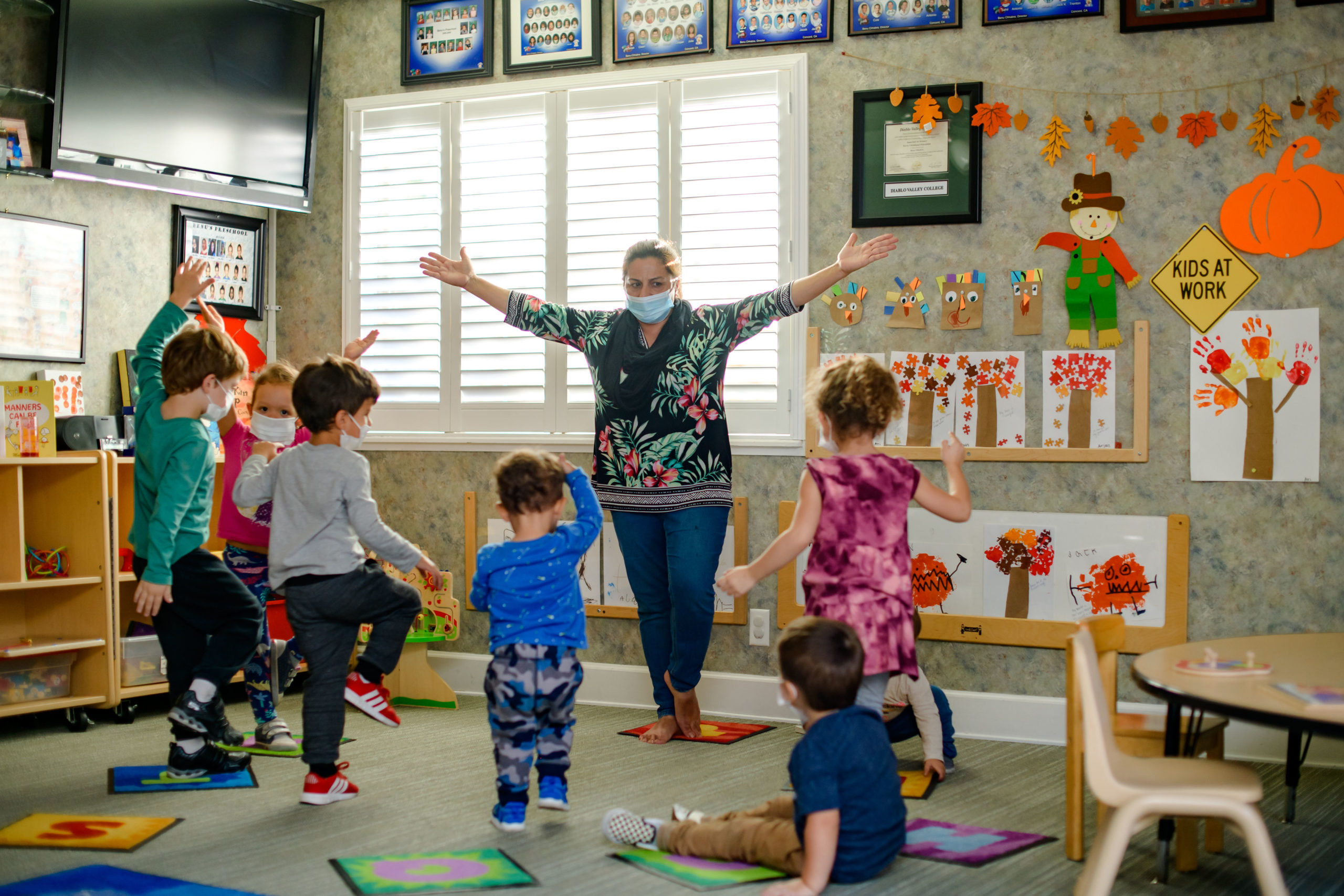Home Based Child Care - Brittany Schultz, owner of Mrs. Brittany Village, a home daycare center in Colorado, takes the kids to the park Sept. 17.
For the past six years, Brittany Schultz has been a Kindergarten teacher in the Denver Public Schools system. On May 28, she left, and on June 15, opened Ms. Brittany's Village Nursery at her home in Commerce City, Colorado, with her three children and a child from another family. Within two months of opening, she said, she was making the same money she was making in class, but she was only responsible for nine children. She and her husband, who is currently working with her, earn about $5,000 a month.
Home Based Child Care

Schultz is a polite and capable woman with the tireless encouragement and focus that are key to working with young children. But even for very active people, going from scratch to opening a daycare center in just a few weeks is amazing. Licensing procedures and safety requirements are important, and can require home renovation. Starting your own business in the face of a pandemic takes courage. And many teachers, especially those with advanced degrees like Schultz, have historically avoided changing careers to what many consider babysitting. Home centers are often considered the used car lot of the US child care system: the place people go when they can't afford them anywhere else, which may be why the number of fully licensed operations has more than halved in the 15 years. the past, from 200,000 to 86,000 approximately.
Building Child Care Infrastructure Through Comprehensive Networks
One reason Schultz was able to move so quickly was because she joined a childcare franchise known as MyVillage, a Colorado startup that matches parents with caregivers, eHarmony-style, and takes care of much of the administrative work, like billing and insurance. MyVillage is one of a growing number of companies—usually with soothing names like Wonderschool, WeeCare, or NeighborSchools—that are trying to use technology to change the daycare industry by creating more home care centers, and improving the reputation and profitability of those already in place. Veterans of childcare centers warn that they have a steep climb ahead.
"I don't want parents to see me as a babysitter," Schultz says, checking on 2-year-old Liam Delgado as his father, Matthew, carries him. "I worked harder than that and put years and years and years into teaching and training."
About 7 million children under the age of 5 are cared for in someone's home, according to the 2016 National Early Care and Education Survey. About 4 million of them are cared for by a relative. The other three million are in home foster homes. Yet despite the number of children they take care of, these home-based nurseries are often overlooked - by policymakers, legislators, parents and associations - since more than 90% of them are unregulated and hard to come by. A clear idea of the level of care. Expanding and improving the sector was one of the centers of a childcare reform initiative Ivanka Trump spearheaded at the White House in December, though it stopped there.
But now a perfect storm has descended on the childcare scene, ravaged by both fronts of fear and opportunity. Many parents, who fear the possibility of contracting COVID-19 in large centers, and have not necessarily returned to work, are looking for smaller, more local options for their children, especially those that will take siblings of different ages. Millennials, who grew up in the sharing economy, already see the home space as multipurpose. Educators like Schultz, frightened by the prospect of learning entirely online, or stuck in schools, are looking for another way to work. Suddenly people need work. And governments and employers have realized that without childcare, their workforce is significantly less productive. Expensive on-site office nurseries sit empty as employees cringe under the double burden of parenting and working from home. Everyone is looking for new solutions.
How Targeted Health And Wellness Efforts Can Strengthen The Home Based Child Care Workforce
These winds are drowning out an American youth welfare system that was already in shambles, and childcare tech entrepreneurs think they have the solution. For a fee, they give home caregivers help with tasks that algorithms do well, including payroll, marketing, billing, and scheduling. They offer curricula, training webinars, mentoring, often a sort of virtual teacher lounge where providers can socialize and schedule or provide support, and a path to licensing. They have search portals to match parents and local service providers. One of them, Wee-Care, suggests that providers can earn $100,000 a year: 300% more than the industry average.
While the pandemic has been difficult for all providers, home centers have proven to be the strongest. The Bipartisan Policy Center (BPC) found that child care centers that operated outside people's homes were the most likely of any type of provider to stay open. More than a quarter of them continued to operate without any interruption, while only 12% of childcare networks continued to operate.
Brittany Schultz started a childcare center in her home in June; She makes more money than I did as a teacher

Representatives of technology-based networks talk about in-home childcare not as a last resort, but as an artificial, homegrown service, childcare version of Airbnb—that could also change the world. "The continuity of care and this partnership that develops between a provider who has worked with the child for several years and a parent, that's its magic," enthuses Brian Schwartz, cofounder of NeighborSchools in Boston. "We believe this is a model for the future of child care in America."
High Child Care Costs Underscore The Need To Support Families With Children
This was not how many parents viewed home day care. “I was worried at first because of all the bad stories on social media about daycare at home,” says Victoria Melanson, who needed to take care of her 3-year-old son after the pandemic hit, older relatives could no longer take care of him. The big chain centers were out of the family's price range, if they were open, so I went with home daycare through NeighborSchools, and love it.
These "carbs," as they might be called, existed before SARS-CoV-2 arrived, but the virus has made their business even more important. WeeCare, the largest of the chains, had 600 registered daycare providers in December, nearly all of them in California. As of October, it has 2,700 suppliers in 25 countries. Wonderschool, which started in 2017 and received a $20 million cash infusion from investors led by Andreessen Horowitz a year later, now has 1,000 centers. Parents' interest has increased greatly, especially for those outdoor centers, some of which are known as forest schools. NeighborSchools and MyVillage have both expanded their geographic reach during the pandemic, and several platforms have started partnerships with companies interested in helping their employees.
Ask any parent about the US childcare system, and you'll be satisfied with a long, exasperating account of the dismal state. “In my city, there aren't a lot of affordable but quality options,” says Mike Schmorro, a lumberjack from Gloucester, Massachusetts. He was not eligible for benefits. Childcare, "Even though I paid the full retail price, I wouldn't be able to afford the cost of living." He ended up sending his son to a day care home a half hour away, which cost him $100 for two days. At the other end of the income spectrum, Sika Chang, who founded WeeCare, was so overwhelmed when she found the care she bought and ran three preschools herself before building her online childcare marketplace. "At preschool, there is no scale," she says.
In many ways, caring for children in a local person's home is one of the oldest and most widespread child-rearing practices we have. Mothers left their children with trusted and experienced neighbors ever since people began to gather in the villages. But perhaps because the work has always been done by women—and, in America, women of color—it does not attract the respect that would logically be bestowed on the people who tend to our newest creatures.
Family Child Care Home Licensing Information
According to Home Grown, a national organization that advocates for home care centers, some of which are called family child care centers or home child care, there are about 1.12 million paid caregivers who work in their own home, of which only 7% — about 86,309 — are fully licensed. These are the ones whose numbers are declining the fastest; More than a fifth of them have closed in the past six years. Experts agree that this decline is one of the main drivers of the growing number of so-called childcare deserts: areas where the demand for childcare far exceeds the supply.
It's not really clear why the in-home daycare sector is shrinking. BPC's Linda Smith believes that retired providers are not being replaced. Chang says she found "a huge disconnect between millennials who are now parents and baby boomers who were all providers. Many of them didn't have websites...or even online ratings."
But almost everyone claims it is simply because the work is hard and the rewards and respect are low. the most my home

Home based primary care, home based child care near me, community based child care, home based care services, home based hospice care, child based jobs, income based child care, child care based on income, home based palliative care, center based child care, home based nursing care, home based care jobs
0 Comments